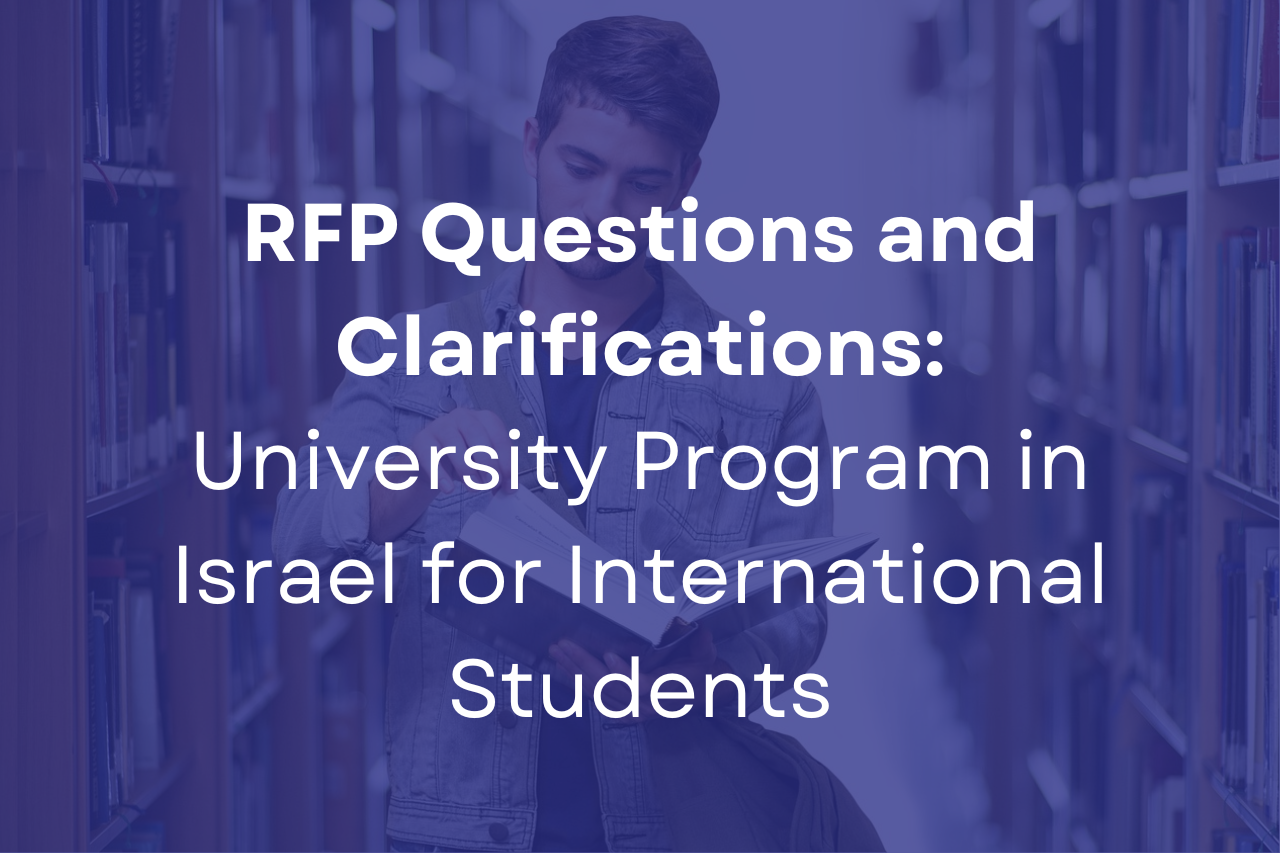The following list of questions were received by Mosaic United during the questions and clarifications window for the RFP, between August 12-29.
*Please note: after the publication of these answers and clarifications, Mosaic (in accordance with Tender process) will not be able to address any further matters. The complete RFP manual will continue to be available for your reference here.
Eligible institutions of higher education are invited to submit applications to the RFP until Sunday, September 15th, 2024 at 23:59. The RFP application form can be found here and any supporting or supplementary information should be submitted by email to Nataly@mosaicunited.org
Notifications about application status will be sent by October 15th, 2024.
Application Timeframe:
- RFP publication: August 12, 2024
- Questions and Clarification period: August 12 - 29, 2024
- Questions or clarifications should be sent to Nataly@mosaicunited.org during this window, after which no further questions can be submitted.
- Answers and Clarifications will be publicized by September 5, 2024
- Application submission deadline: September 15, 2024
- Acceptance: Notifications, contracting and target-setting with accepted institutions: September 26 - October 15, 2024
Questions and Clarifications
1. Is the maximum support from the Government of Israel (GOI) / Mosaic each year $250,000, with an additional $250,000 in matching funds from the institution?
The maximum allocation that an institution may receive from Mosaic United for this initiative is $250,000 per year up to two years, proved that the institution is able to match the funds in an equal amount (and not exceeding $500,000 per year combined).
2. When it comes to start-up funding for supplemental programming, does the amount of $6,000 per student represent the government share/Mosaic, to which an additional $6,000 per student in matching from the institution should be added, or is the amount of $6,000 (actually broken down to $3,000) from the government share/Mosaic and $3,000 in matching from the institution?
The start-up supplemental funding is $6,000 total per student per year, which is contingent on 50/50 matching funds from the Institution of up to $3,000.
3. Can you clarify what up to $250,000 means?
A. Is this an amount per year or for over two years?
B. Is this the total amount that the government provides, or does this amount include matching from the institution?
The maximum each eligible institution may receive from Mosaic United (Mosaic share) is $250,000 in year 1 and $187,500 (75% of the maximum year 1 allocation) in year 2, pending the Institution’s ability to provide matching funds in an equal amount to that allocated by Mosaic United. Meaning, over a two-year period, an eligible institution may receive up to $437,500 total from Mosaic, not exceeding $250,000 in a one-year period, according to the approved allocation laid out by Mosaic United and pending matching funds of the equivalent amount of the allocation provided by Mosaic United.
Maximum potential allocation breakdown:
Mosaic Share
Institution Share
Total
Year 1
$250,000
$250,000
$500,000*
Year 2
Up to 75% of Year 1 allocation,
not exceeding $187,500
Up to 75% of Year 1 allocation,
not exceeding $187,500
Up to 75% of Year 1 allocation, not exceeding $375,000 total and $150,000 of marketing expenses (for start-up only)*
* Marketing expenses cannot exceed 50% of a given proposal or $200,000, whichever is the lower of the two. In year two, for start-ups only, marketing expenses cannot exceed 50% of a given proposal or $150,000, whichever is the lower of the two.
4. What does it mean that in the second year 75% will be given?
Is it 75% of the government/Mosaic share of $250,000? Will the 75% be given to both supplemental and marketing?
In the second year, contingent on the degree to which they met their target in Year 1, an institution will be eligible to receive up to 75% of their year-one allocation. The start-up track will be eligible to receive said year 2 funding in both the marketing and supplemental programming categories. Pre-existing programs will only be eligible to receive said year 2 funding in the supplemental programming category.
5. What do you mean by "mifgash"? What is required? Is a declaration of intent sufficient for a meeting to take place in cooperation with AMI?
A “mifgash” means a meaningful encounter between similarly aged Israeli and International students. At least 2 points per year will go towards a mifgash experience, planned and funded in conjunction with AMI. AMI has unique expertise in Israeli mifgash experiences. The applying institution is invited to include additional mifgash programming with or without AMI partnership. Applying institutions may provide a declaration of intent and/or indicate in their summary of proposed activity which activities will include a mifgash experience and how they envision the mifgash taking place pending conversation and coordination with AMI (pending approval of their application).
(Mosaic wishes to clarify that the partnership with AMI for the mifgashim does not require the applicant to contact or coordinate with AMI prior to submitting an application. Further details of the relationship with AMI will be delineated further along the process should the applicant proceed to the contract phase).
6. At the submission stage, is it sufficient to submit names of the activities and their scope without elaborating on the details of the content, for example: do we need to include course syllabi already at this stage?
Application submission for the supplemental programming track must include an attachment summarizing the proposed content for which they are applying to receive funding, including all necessary details to show that it meets the supplemental programming criteria (see further details in the RFP Manual appendix “Additional Detail and Criteria”). A course syllabus is not necessary at this stage.
7. Application submission:
A. During the online submission process is it possible to go back while writing the proposal to make corrections?
B. If the proposal was submitted before the final submission deadline and we would like to make changes to the proposal that has already been submitted - can we do so (as long as, of course, it is before the deadline for submission)?
A. Yes, it is possible to go back and make corrections.
B. No, once submitted, the application will be considered final.
8. When applying together with a university, can the partnering organization be the grant submitter/applicant?
No, the institution of higher education itself must be the applicant, but it can partner with or outsource to an approved provider for marketing, recruitment, and program delivery. The Israeli institution of higher education will be instructed to submit documentation of the partnership with the partnering organization.
9. In the case of such a partnership, what role can the partnering organization play in the financing, both with regard to receipt of grant and payment of the matching funds?
All funding must go through the institution of higher education, which can in turn pay the partner organization/provider. A partner organization can invoice the institution of higher education and/or provide receipts. A partner organization may participate in meeting the matching funds criteria. Supporting funds must be provided to the institution of higher education who will in turn provide them to Mosaic United as match funds.
10. What elements need to be included in the contract between partnering organizations and the institution of higher education?
- If the partner organization is taking part in contributing to the matching fund requirement a document formalizing the partnership and its conditions such as an affidavit signed by both partners must be submitted at the time of application.
- If the applicant is an international institution of higher education partnering with an Israeli institution of higher education, documentation of said partnership must be provided at the time of application.
- If none of the above, no formal documentation needs to be provided.
11. In addition to applying in partnership with our university partners, can a partner organization apply alone?
The applicant must be an internationally accredited academic institution, offering recognized credits/transcripts. Institutions can include both Israeli and international institutions of higher education, provided they have a partnership or are hosted by an Israeli institution.
12. A partner organization is planning to apply in partnership with more than one University partner. Can the partnering organization apply multiple times with different institutions of higher education in order to service different colleges and populations?
If the partner organization is not itself a credit issuing institution of higher education, it cannot apply on behalf of the institution of higher education. A partner organization can be listed/mentioned in multiple applications received from varying institutions of higher education.
13. Are personnel salaries an acceptable marketing expense?
Personnel costs associated with recruitment and marketing can be listed as a marketing expense.
14. When should an applicant apply for a second year of funding, at the time of initial application or at second stage for those who received a first round of funding?
If a second year of funding is desired, it should be included in the original application at the time of funding. If granted, a second year of funding and allocated amounts will be contingent on demonstrated success in year one.
Additional Clarification: An international student who is studying towards a BA in Israel and who is or has received funding from a Government of Israel source other than Mosaic (e.g. MASA) is eligible to be counted for funding purposes under the Mosaic United initiative after the student and/or the institution no longer receive said governmental funding for said student and that the student is no longer eligible to be counted for MASA funding.
The Questions and Clarifications period is now closed





